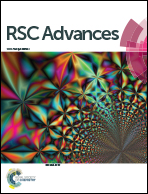Iron–copper bimetallic nanoparticles supported on hollow mesoporous silica spheres: an effective heterogeneous Fenton catalyst for orange II degradation†
Abstract
Iron–copper bimetallic nanoparticles supported on hollow mesoporous silica spheres as a composite catalyst (FeCu/HMS) was synthesized via a post-impregnation and sodium borohydride reduction strategy. The catalyst was characterized by X-ray diffraction, X-ray photoelectron spectroscopy, nitrogen physisorption, scanning electron microscopy, transmission electron microscopy, Fourier transform infrared spectroscopy and zeta potential. The results showed that the FeCu/HMS catalyst possessed hollow mesoporous structure with interior cavity transfixed by mesoporous silica shell. The iron–copper nanoparticles highly dispersed in the matrix of hollow mesoporous silica spheres. For comparison, three other catalysts, including solely iron nanoparticles supported on hollow mesoporous silica spheres (Fe/HMS), solely copper nanoparticles supported on hollow mesoporous silica spheres (Cu/HMS) and iron–copper nanoparticles supported on solid-core structured mesoporous silica spheres (FeCu/MS), were prepared by the similar procedure. To demonstrate the heterogeneous Fenton catalytic performance of the as-synthesized FeCu/HMS, orange II was chosen as a model contaminant. The results showed that 90.2% of 50 mg L−1 orange II was removed during 15 min at the reaction conditions of 1 g L−1 catalyst and 13.7 mM H2O2 in neutral pH and room temperature, and raised to 94.3% at 2 h. Kinetic analysis showed that the degradation of orange II follows the pseudo-first order and the apparent rate constant of FeCu/HMS was much higher than those of as comparison catalysts. Additionally, it was found that the addition of copper could make the catalyst less pH dependent and keep the high activity (93.8% orange II removal efficiency) even at alkaline circumstance (pH = 9). The remarkable catalytic performance of FeCu/HMS may be ascribed to the synergetic effect of iron and copper and “cavity effect” of the hollow structure. The stability and recoverability of the catalyst were assessed. The results indicated that the catalyst retained high catalytic activity (78.9% orange II removal efficiency) after 5 consecutive runs. The unique nanostructure and efficient catalytic activity make the catalyst to be a novel and prospective candidate in heterogeneous Fenton chemistry.


 Please wait while we load your content...
Please wait while we load your content...